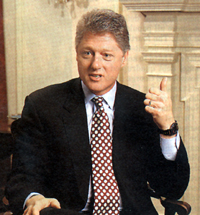































|
 November/December, 1998 Volume XIII Number 3
November/December, 1998 Volume XIII Number 3


Moral madness, moral insanity
By Harold O.J. Brown
Children can be dangerous," The Charlotte Observer opines, "but they still aren't adults." Andrew Golden was 11 on March 24. That was the day that he and Mitchell Johnson, then 13, set off a fire alarm at Westside Middle School in Jonesboro, Tennessee. As the pupils streamed out of the school, they were met with some well-directed rifle fire by the two boys, killing five and wounding nine.
Mitchell pleaded guilty to multiple counts of murder; little Andrew, who has turned 12, pleaded not guilty. His attorney declared him insane, incompetent to stand trial but the judge would not permit him to plead insanity. Andrew was also convicted. The two very young-looking juveniles have had a moment of fame. They were pictured on the cover of national news magazines, and one photo showed Andrew at age three dressed in pseudo fatigues and holding a rifle.
Front-page newspaper photos depicted the two frail-looking boys being led into the Craighead County Courthouse with chains on their wrists and about their waists, each held by two burly officers of the law, to hear the verdict and their sentencing. No doubt the law requires that persons charged with capitol crimes be transported with such physical restraints, although it seems a bit ludicrous when the perpetrators are little boys. The whole business is "funny," but funny as in insane, not funny as in amusing.
Now, after the fact, after four have been buried and nine are recovering, one of the boys is professing remorse.
"I didn't mean to do it." Mitchell Johnson, whose rifle fire killed the popular teacher Shannon Wright and his schoolmate Stephanie Johnson, stated that he had never meant to shoot anyone. "I am sorry," said Mitchell, who turned 14 on the day of his conviction.
His claim that he did not intend to kill anyone was rather unconvincing, since he used a rifle with a telescopic sight and hit Mrs. Wright twice, fatally wounding her. That's hard to do unintentionally. The murdered teacher had given the other boy, Andrew Golden, extra attention; perhaps that is why Andrew aimed at two young girls instead of her.
The boys were given the most severe sentences the law allows: they were remanded to a juvenile detention facility until they reach the age of twenty-one, when they will be freed. This is what the law requires for dealing with juvenile offenders: that juveniles might commit murder, not to say multiple murders, was not foreseen. (This particular law has not been modified to correspond to the reduced age of adulthood, eighteen.)
One boy's father expressed the fear that his son may be subjected to sexual abuse in confinement. Relatives of the slain and wounded victims were distressed at the prospect of seeing the murderous children set free after seven and nine years, respectively, whether or not they suffer abuse - about four years' detention per murder victim, not counting the wounded. If one were to apply the biblical standard, " ...Deliver him into the hand of the avenger of blood, that he may die. Thine eye shall not pity him, but thou shalt put away the guilt of innocent blood from Israel" (Deuteronomy 19:12-13), the boys would have to be put to death. It is difficult to contemplate the prospect of executing young boys, but there would be a certain symmetry to do so, as the Bible recognizes. The Old Testament does not consider the concept of diminished responsibility of the insanity defense, to which the argument that youth mitigates the severity of the crimes is related.
The thought of executing children is horrible, but one must acknowledge that the act of these children was also horrible. The possibility of getting one's picture on the cover of Newsweek by such a daring action may appeal to some juvenile minds, and it is not absurd to suppose that the nationwide media coverage accorded the earliest of these incidents - for there have been at least four - may have contributed to later ones. Perhaps the threat, or rather the cruel reality, of capital punishment would discourage imitation by other youngsters. But this was not a consideration; it could (and probably should) not be. The law of Tennessee is explicit and clear, and the sentences imposed were all that it allows.
We know what the law specifies; this does not tell us what would be the morally appropriate disposition of the case. The Charlotte newspaper rather approves of the outcome. In saccharine tones it writes: "Our laws reflect our knowledge that youths aren't capable of exercising adult responsibility. The law must recognize that presumed lack of responsibility when young people commit crimes, too. A good juvenile justice system should have multiple goals: to protect society and punish wrongdoing, of course, but also to turn law-breaking children into law-abiding children and adults, when possible."
This is not exactly saying, "Boys will be boys" (which would be an impossibility in this age of political correctness), but it comes close. Short of a true spiritual transformation, it is hard to imagine that the two Jonesboro boys will emerge from "juvenile detention" as nice, clean law-abiding young men.
The media reaction to Jonesboro and related phenomena reveals a kind of moral schizophrenia, or moral insanity. Killing teachers and children in a schoolyard is horrible, executing young murderers is unacceptable, but killing babies by the hundreds of thousands in the womb, including just as they emerge from it, that is freedom, that is choice, that is the triumph of our liberal spirit in our pluralistic society.
The Observer, like many other media, is "pro-choice" when the matter at hand is abortion; young girls must be allowed to procure abortions without the knowledge, not to say consent, of their parents. The fact that young boys can commit multiple murders and receive sentences no longer than might be imposed for stealing a car or burglary is bizarre in itself, but our society is full of bizarre contradictions where morals are concerned. It is bizarre that a society that holds that juvenile boys are too immature to be punished as seriously as a capitol crime merits, holds juvenile girls are mature enough to engage in what we used to call illicit sex and to destroy by abortion any offspring that might result. Indeed, the right to abortion, made virtually absolute by the U.S. Supreme Court, has been defended up to the last minutes or inches before birth by President Clinton, who has twice vetoed the bill banning partial birth abortions.
Willing Executioners
Last year historian Daniel Goldenhagen caused a sensation with his book Hitler's Willing Executioners, in which he argued that the majority of Germans went along more or less voluntarily and willingly as Goldenhagen would have it, in a culpable spirit of self-deception, resolved to "see no evil."
The public reaction to the Jonesboro murders does not reflect a tendency to ignore all evil; it shows a willingness to see some evil but this willingness makes the lack of reaction of the media and the public to other evils appear puzzlingly inconsistent.
Politically Protected
Much - probably too much - has been said and written about the White House follies, President Clinton, and what are and are not considered sexual relations. The President and a number of his counselors and associates have enjoyed a high degree of political protection for conduct for which other men would experience swift, if not necessarily just, vengeance. But it is not only presumed presidential proclivities that are politically protected (at least for an extended time). Abortion, including partial birth abortion, enjoys a high degree of protection, but anyone doing violence to an abortion clinic will be pursued with energy like that employed against terrorists who blow up a U.S. embassy.
In western North Carolina 200 police officers and FBI agents have been searching for Eric Rudolph, the man accused of the January 29 bombing of an abortion facility in Birmingham, Alabama, the first such incident to cause a fatality. Rudolph is on the FBI's Ten Most Wanted list, a distinction that he earned not by the number of his alleged victims but by the fact that his target is politically protected. In mid-August, the search party was reduced to 80.
Other Inconsistencies
In a major essay in the Weekly Standard, Dennis Praeger discusses the extent to which the war on smoking is based on misinformation, on deceit, and in many cases on outright greed.
Smoking may and often does damage smokers' health and shorten their lives, but it is not at all clear that smoking increases health care and welfare costs, inasmuch as smokers who become ill will presumably die earlier, use less medical care over the entire period of their lives, and receive fewer retirement benefits. Non-smokers also die, and the costs of non-smoke-related final illnesses can be just as high as those of smokers.
 The anti-smoking campaign is supposedly designed to protect our teenagers, 3000 of whom begin smoking every day, and 1000 of whom will die prematurely, according to President Clinton's constant echoed misquotation of a statistic involving an older class of young adults.
The anti-smoking campaign is supposedly designed to protect our teenagers, 3000 of whom begin smoking every day, and 1000 of whom will die prematurely, according to President Clinton's constant echoed misquotation of a statistic involving an older class of young adults.
A teenager can smoke quite a few cigarettes before getting into real trouble, but premarital sexuality can and frequently does lead to much more immediate serious consequences. A smoker who began as a teenager can give it up at the age of twenty-five or thirty, but a girl who has become pregnant in high school or college will have immediate and long-lasting consequences with which to contend. Smoking is pursued with ferocity, while at the same time a more immediate threat, that of various curable and incurable venereal diseases and of the uniformly fatal malady AIDS, is treated in such a trivializing and unrealistic way in sex education classes that it virtually promotes the conduct that leads to teenage sex and thus infection.
An Underlying Cause
In a recent issue, the evangelical periodical Christianity Today placed much of the blame for juvenile violence on the media culture. There are at least two reasons why the pervasiveness of gruesome violence in the media, especially in that omnipresent medium television, generates imitaiton: one is its realism, the other is its unreality.
The carnage looks real and fascinates as acting upon a stage never could. But television is not reality. Children-and adults-watching it may not process it as real, and may, without realizing it, think that they can perform similar feats with no more serious consequences than having to change channels. Thus little Andrew, after killing two schoolmates, said that he wanted to go home, that he wanted his mother. The media culture is so pervasive, so habit-forming, so seductive, so inebriating, that it is hard to imagine how it can be resisted or blocked, short of a total and nationwide cutoff of all electrical power.
OTHER
FEATURE
ARTICLES
Hugh Finn
An Emty Cradle, A Full Heart
36 points in regards to the Pittsburg Nightmare Case
Moral madness, moral insanity
The myth of safe abortions

|
|



